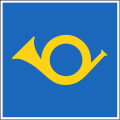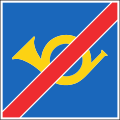Priority signs
This article needs additional citations for verification. (December 2009) |
Priority
Types of sign

A Give way sign, also known as a yield sign in some countries, informs the driver that they must give way to vehicles on the major road. Under the Vienna Convention, the standard sign should be a white or yellow inverted triangle with a red border.[1] This originates in Denmark, with the red and white coming from the Danish flag.[2] In some countries, the words Give Way or equivalent may be included with the sign. These signs are usually accompanied by a give way marking, normally one or multiple dashed lines or shark teeth across the carriageway.
| Priority signs according to the Vienna Convention on Road Signs and Signals | ||||||
|---|---|---|---|---|---|---|
| Give Way | Inverted equilateral triangle | White or yellow | Red | 0.9 m (large), 0.6 m (small) | None | |
| Stop | Octagon | Red | White | 0.9 m (large), 0.6 m (small) | "STOP" written in white | |
| Circular | White or yellow | Red | 0.9 m (large), 0.6 m (small) | "STOP" written in black or dark blue inside red inverted triangle | ||
| Priority road | Diamond | White | Black | 0.5 m (large), 0.35 m (small) | Yellow or orange square | |
| End of priority road | Diamond | White | Black | 0.5 m (large), 0.35 m (small) | Yellow or orange square with black or grey diagonal lines crossing the sign | |
| Priority for oncoming traffic | Circular | White or yellow | Red | Unspecified | Black arrow indicating direction with priority, red arrow indicating direction without | |
| Priority over oncoming traffic | Rectangle | Blue | None | Unspecified | White arrow indicating direction with priority, red arrow indicating direction without | |
Alternative priority systems
-
Sign indicating the route of priority road (thick line) at an intersection and defining the priority
-
Dangerous intersection with priority indication (for the next intersection only). Different variants of the sign can be used on both priority- and non-priority roads. Each sign has the thicker line indicating the road or direction that has priority with the viewer's own direction being from the bottom of the sign.
-
Swissmountain postal road sign: priority given to public transport, such as postal bus (pay special attention to the specific three-tone-horn of the postal bus approaching hairpin bends and wait before the bend; traffic users must follow instructions given by public transport drivers)
-
Swiss End of mountain postal road
-
AFilter in turn in the Channel Islands, which indicates that traffic from different approaches has alternating priority at the junction.
See also
References
- ^ "Road Traffic and Road Signs and Signals Agreements and Conventions | UNECE". unece.org. Retrieved 2021-09-12.
- ^ Bekendtgørelse om Hovedfærdselsaarer, 27. marts 1937, Denmark





